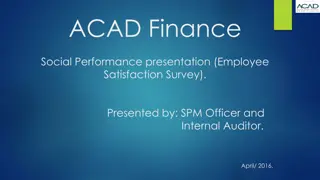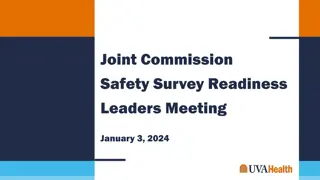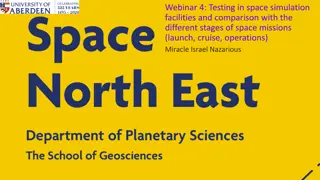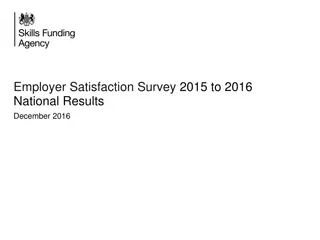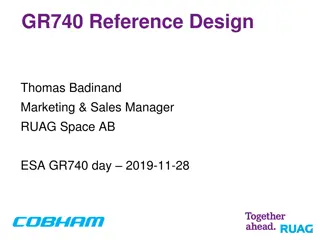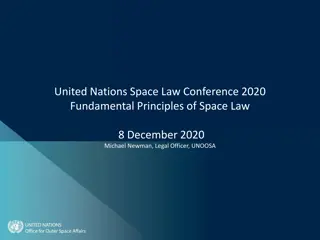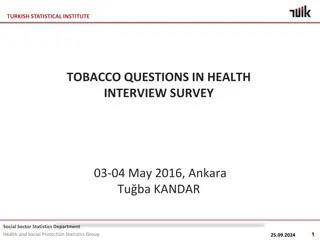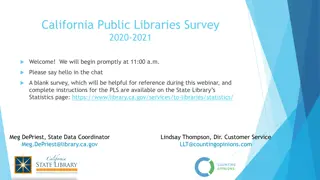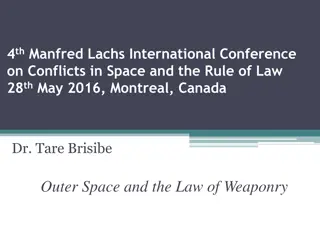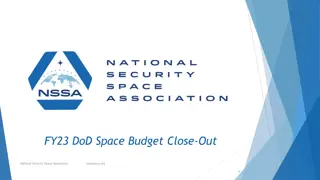Important Space Survey Process for FY 2016
A space survey is crucial for identifying and categorizing institutional space usage to determine Facilities and Administrative rates submitted to the Federal Government. Errors can lead to significant reductions in rates, making trained coordinators essential.
Download Presentation

Please find below an Image/Link to download the presentation.
The content on the website is provided AS IS for your information and personal use only. It may not be sold, licensed, or shared on other websites without obtaining consent from the author.If you encounter any issues during the download, it is possible that the publisher has removed the file from their server.
You are allowed to download the files provided on this website for personal or commercial use, subject to the condition that they are used lawfully. All files are the property of their respective owners.
The content on the website is provided AS IS for your information and personal use only. It may not be sold, licensed, or shared on other websites without obtaining consent from the author.
E N D
Presentation Transcript
What is a Space Survey? A space survey is the process of: Verifying the physical attributes assigned to rooms/space (department, room type, etc.) Assigning institutional space into the functional categories defined by the Federal Government (Instruction, Public Service, Organized Research, etc.) based on how the space was used throughout the year.
Why is the Space Survey Important? Space survey results will be used to calculate the Facilities portion of the Facilities and Administrative (F&A) rates that are submitted to the Federal Government. WVU must submit a new F&A rate proposal based on FY 2016. Results are guaranteed to be audited by our cognizant Federal agency.
WVUs F&A Rate and Potential for Growth WVU's Facilties and Administrative Rate 60.0% Over Admin. Cap 50.0% 40.0% Administrative Component (26% cap) Facilities Component 30.0% 20.0% 10.0% 0.0% WVU Over Admin. Cap Administrative Component (26% cap) Facilities Component 6.8% 26.0% 24.0%
Governments perspective on Space Believe it s the most equitable means to allocate space related costs Space should match the base Important for Departmental Space Coordinators to be adequately and consistently trained Inconsistencies and/or errors with coding space can result in significant disallowances and reductions in the University s F&A rates
What is the Role of the Departmental Space Coordinator? Act as the primary department contact for space survey issues Be the primary source for room use and room occupants Be the key link to Principal Investigators and other personnel involved with sponsored projects to discuss space coding Knowledgeable about the financial accounts of the department
Space Survey Rooms assigned to each department Square footage of room Room type (classroom, research lab, office) Occupants Functionalize consistently Prorate using total time spent (not 8 hours/day) Average for whole year Identify funding source for Organized Research and Other Sponsored Activities
Functional Definitions Instruction and Departmental Research (IDR) Organized Research (OR) Other Sponsored Activities (OSA) Departmental Administration (DA) Other Institutional Activities (OIA) Animal Quarters (ANQ) Vacant( VAC)
Instruction & Departmental Research (IDR) Space used for teaching and sponsored training activities, course preparation, classroom instruction, study areas for students, academic advising of students by faculty, and any other activities that involve credit or non-credit.
Instruction & Departmental Research (IDR) This also includes Departmental Research activities which are research, development and scholarly activities that are not separately budgeted and accounted for (and don t meet the definition of Organized Research).
Organized Research (OR) Research & Development (R&D) activity that is either: Sponsored Research University Research R&D activities supported by either of the following Cost share expenses that support organized research projects. Continued on next slide
Organized Research (OR) WVU/WVURC funded projects that have at least two of the following characteristics: Defined scope of work, Separately budgeted and accounted for, Specific commitment regarding deliverables and the level of personnel effort, Utilization and assignment of space, A formal report or response summarizing results/conclusions.
Departmental Administration Space used by department heads, deans, faculty or clerical staff for department administrative purposes that benefit multiple departmental activities. This includes common use space that is utilized by the entire department that may include copy rooms, conference rooms, break rooms, and file rooms.
Other Sponsored Activities (OSA) Space used for activity that is neither research nor instructional, however funded by an external source (grant, contract, or cooperative agreement). Examples of such programs are health service projects, drug studies (human subjects) and community service programs. WVU Extension public service functions are coded as OSA.
Other Institutional Activities (OIA) Space used in conducting activities that cannot be classified into any other functional category. Consider the previous functions prior to selecting this category. Patient Care Activities (except as they are related to sponsored clinical trials or drug studies). See Space Inventory Guide for more examples. (alumni activities, fundraising, public relations, student clubs or organization activities, etc.)
Vacant (VAC) Space that is not being used now and has been vacant for more than six months of the fiscal year FY16.
Sample Work Plan Preparation List of Faculty and Faculty Offices and Labs Identify all Post-doc s, Research Associates, Lab Tech s List of Graduate Students by type GRA and GTA Room listing (WebSpace) Account listing with PI Floor Plans Review Documents Definitions Space and accounts
Sample Work Plan Complete Survey Identify and functionalize DA (Departmental Admin) Identify and functionalize all 100% Instruction & Departmental Research Class labs w/o OR Classrooms Determine functional % for the remaining space and assign accounts Coordinate with Dept. Chair Coordinate with Faculty Conduct Interviews, visits Use professional judgment
Sample Work Plan Update Results in WebSpace Review final results Submit Space Survey Certification to Cost Accounting Organize Work/Results for Potential Review Documentation VERY IMPORTANT Retain sufficient documentation to support the coding of space particularly Organized Research space. Federal Auditors will come to WVU and walk the space to review coding.
Considerations Rooms coded 100% Org. Research Too many rooms 95:5 Graduate Research Assistants/Students (How are they funded when in the lab do they do homework in the lab?) Visiting Professors and Emeritus Faculty If space provided as a courtesy and not paid with WVU funds, space should be coded as OIA Seed Money and Overhead Return Funds most often should be Instruction/Departmental Research
Considerations Proposal Writing If for a sponsored agreement, should be DA. If for a gift, should be OIA. Conference Rooms Department Libraries usually DA Shared Labs consider how both areas use the lab and who is in it. Class labs and Classrooms - Instruction Faculty offices remember to consider all the student advising, office hours, mentoring, etc.
Potential Audit Issues Lack of experience in Uniform Guidance functional use definitions Interpretation and inadequate communication of instructions/training Lack of consistent application of instructions Cost Sharing (mandatory & voluntary committed) Effort and space incurred on sponsored activity, however funded by the University
Space Survey Timeline Target completion date: July 15, 2016 Cost Accounting unit will provide additional training and assistance to anyone that needs it. Any questions or concerns: Jaime Bunner 293-3539 or Jaime.Bunner@mail.wvu.edu Rachel Duzan 293-4009 or Rachel.Duzan@mail.wvu.edu spacesurvey@mail.wvu.edu
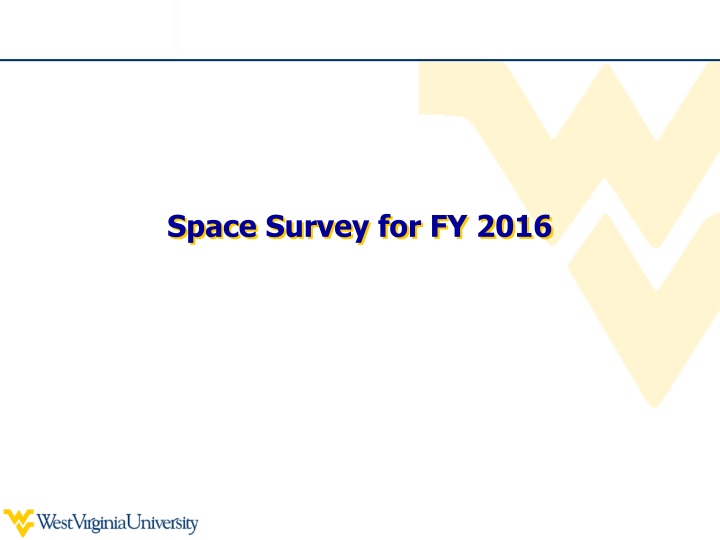

![Read⚡ebook✔[PDF] Linking the Space Shuttle and Space Stations: Early Docking Te](/thumb/21519/read-ebook-pdf-linking-the-space-shuttle-and-space-stations-early-docking-te.jpg)
![READ⚡[PDF]✔ Emerging Space Powers: The New Space Programs of Asia, the Middle Ea](/thumb/21554/read-pdf-emerging-space-powers-the-new-space-programs-of-asia-the-middle-ea.jpg)







